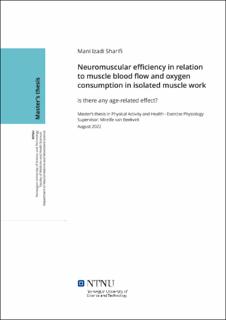| dc.description.abstract | Abstract
Background: It is well-established that aging is associated with declined muscle mass and force. However, the impacts of age on neuromuscular efficiency, muscle blood flow and oxygenation, and their association are less clear. Objective: The present study investigates whether advanced age affects neuromuscular efficiency, muscle blood flow, and mV̇O2 in isolated muscle work and if neuromuscular efficiency is associated with O2 delivery and extraction. Methodology: 11 young (26.45±7.38 years) and 12 older (64.41±3.94 years) adults participated. All were healthy and recreationally active. An incremental handgrip test was conducted to determine maximal handgrip load. Bouts of dynamic handgrip exercise at work rates 10, 30, 50, 70, and 90% of maximal handgrip load were performed. Force/EMGRMS was used as a measure of neuromuscular efficiency. Blood flow and mV̇O2 were evaluated using NIRS and venous occlusion. All measurements were done in two forearm muscles, flexor digitorum superfacialis and brachioradialis. Results: Young showed higher neuromuscular efficiency than the older group, only for brachioradialis (borderline significant effect, F(1,21)=4.04, p=0.05). There was also a significant group-by-WR interaction effect for blood flow in brachioradialis (F(4,82)=3.27, p=0.01). Except for three significant associations out of 40 tested (p<0.05), neuromuscular efficiency was poorly associated (p>0.05) with muscle blood flow and mV̇O2. Conclusion: The findings of this study demonstrate some differences in the rate of muscle aging within forearm musculature since flexor digitorum superfacialis function appears to be preserved with age while there were declines in brachioradialis. Moreover, muscle O2 delivery and extraction do not seem to affect neuromuscular efficiency.
Keywords: muscle aging, forearm musculature, dynamic exercise | |
